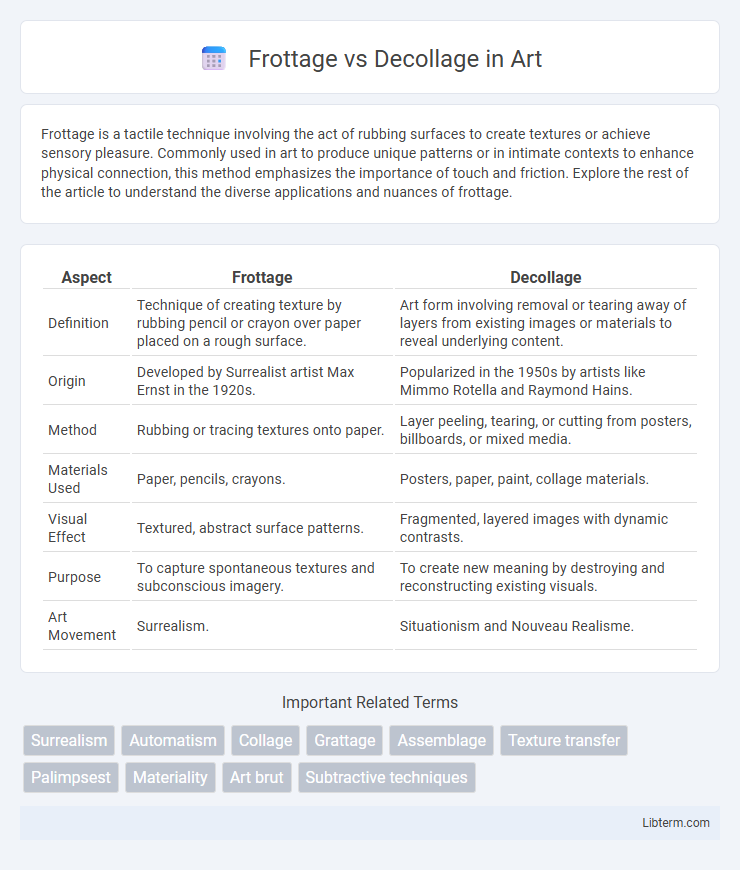Frottage is a tactile technique involving the act of rubbing surfaces to create textures or achieve sensory pleasure. Commonly used in art to produce unique patterns or in intimate contexts to enhance physical connection, this method emphasizes the importance of touch and friction. Explore the rest of the article to understand the diverse applications and nuances of frottage.
Table of Comparison
| Aspect | Frottage | Decollage |
|---|---|---|
| Definition | Technique of creating texture by rubbing pencil or crayon over paper placed on a rough surface. | Art form involving removal or tearing away of layers from existing images or materials to reveal underlying content. |
| Origin | Developed by Surrealist artist Max Ernst in the 1920s. | Popularized in the 1950s by artists like Mimmo Rotella and Raymond Hains. |
| Method | Rubbing or tracing textures onto paper. | Layer peeling, tearing, or cutting from posters, billboards, or mixed media. |
| Materials Used | Paper, pencils, crayons. | Posters, paper, paint, collage materials. |
| Visual Effect | Textured, abstract surface patterns. | Fragmented, layered images with dynamic contrasts. |
| Purpose | To capture spontaneous textures and subconscious imagery. | To create new meaning by destroying and reconstructing existing visuals. |
| Art Movement | Surrealism. | Situationism and Nouveau Realisme. |
Introduction to Frottage and Decollage
Frottage is an artistic technique that involves creating texture and patterns by rubbing a pencil or other drawing tools over paper placed on a textured surface, capturing the underlying relief. Decollage, contrastingly, entails cutting, tearing, or removing layers from posters or other materials to reveal fragments beneath, emphasizing destruction and reconstruction in art. Both methods explore surface manipulation but differ fundamentally in their approach to uncovering imagery and texture.
Defining Frottage: Technique and Origins
Frottage is a surrealist technique developed by Max Ernst in the 1920s that involves creating rubbings from textured surfaces to generate spontaneous patterns and imagery. This method captures intricate details from materials like wood, fabric, or leaves by placing paper over them and rubbing with a pencil or crayon. Frottage's origins lie in Ernst's pursuit of unlocking the subconscious through automatic processes, contributing to its significance in avant-garde art movements.
Understanding Decollage: History and Methods
Decollage is an art technique that involves tearing away or removing layers of posters, photographs, or other materials to reveal underlying images, creating a dynamic collage effect. Originating in the mid-20th century, artists like Raymond Hains and Jacques Villegle pioneered decollage as a form of street art and cultural commentary, emphasizing urban life and media saturation. This method contrasts with frottage, which involves rubbing to capture surface textures, as decollage focuses on destruction and revelation through subtraction.
Key Differences Between Frottage and Decollage
Frottage involves creating texture by rubbing a pencil or other drawing tool over a textured surface to capture its pattern, emphasizing additive techniques in artwork. Decollage, on the other hand, is a subtractive art form where layers of posters or paper are torn away to reveal underlying images, highlighting removal and degradation processes. Key differences include the method of image creation--frottage uses layering of textures through rubbing, while decollage relies on physical tearing and removal to form the final composition.
Notable Artists Who Used Frottage
Max Ernst is a pioneering figure who popularized frottage, using this technique to create textured, dreamlike surfaces that challenged traditional artistic methods. Other notable artists include Alberto Giacometti, who incorporated frottage to explore spatial depth and texture in his works. Hans Hartung also experimented with frottage, employing it to enhance the dynamic and abstract qualities of his compositions.
Influential Decollage Practitioners
Influential decollage practitioners such as Raymond Hains, Jacques Villegle, and Mimmo Rotella pioneered this disruptive art form by tearing and peeling layered posters to reveal fragmented images and text beneath. Their work challenged traditional collage by emphasizing destruction and urban decay, creating dynamic compositions rooted in the tactile experience of layered public spaces. This method transformed everyday advertising into powerful critiques of consumer culture and mass media.
Materials and Tools: Frottage vs Decollage
Frottage utilizes textured surfaces such as wood grain, leaves, or fabric combined with pencils, crayons, or charcoal to capture intricate rubbings, emphasizing the transfer of texture onto paper. Decollage involves the layering and deliberate removal of materials like posters, paper, or paint using tools such as knives, scrapers, or solvents to reveal hidden layers beneath, creating dynamic visual contrasts. While Frottage focuses on additive techniques for texture replication, Decollage relies on subtractive methods that manipulate physical layers for artistic effect.
Artistic Intent: Purpose Behind Each Technique
Frottage involves rubbing a textured surface to create spontaneous patterns that emphasize subconscious expression and chance in art. Decollage, conversely, focuses on unveiling hidden layers by tearing away parts of posters or images, highlighting themes of destruction, revealment, and social critique. Both techniques challenge traditional representations by prioritizing texture and the unexpected, but frottage seeks to capture accidental impressions while decollage intentionally deconstructs visual narratives.
Modern Adaptations in Contemporary Art
Frottage and decollage have been reinterpreted in contemporary art through innovative techniques such as digital manipulation and mixed media installations, expanding their traditional boundaries. Artists leverage frottage to capture textures from urban environments, transforming everyday surfaces into layered visual narratives, while decollage is employed to deconstruct and reassemble advertising posters or urban signage, creating dynamic compositions that critique consumer culture. These modern adaptations emphasize materiality and process, reflecting contemporary concerns with memory, decay, and the intersections of art and public space.
Choosing Between Frottage and Decollage
Choosing between frottage and decollage depends on the desired artistic effect and technique. Frottage involves creating texture by rubbing a pencil or crayon over a surface, capturing the underlying patterns, making it ideal for detailed, textural studies. Decollage, involving cutting or tearing away layers of posters or paper, produces a dynamic, fragmented aesthetic suited for expressive, layered compositions.
Frottage Infographic

 libterm.com
libterm.com